For youth around the world, fashion has always been a silent language that speaks volume. At various points in time, youth’s views on fashion have always been different from the mainstream.
The state of youth fashion
For youth around the world, fashion has always been a silent language that speaks volume. At various points in time, youth’s views on fashion have always been different from the mainstream. They chose to wear what truly represented them as individuals; and as result, their choices helped them live life to the fullest.
I remember cringing when my friend wore hot-pepper themed earrings to the University. Classmates tried making her uncomfortable with their gazes without even realizing that her choice empowered her.
Several fashion movements were sparked by youth in the West; the sense of defiance and desire for personal freedom in their expression still fascinates the fashion world.
Hippies - the rise of fearlessness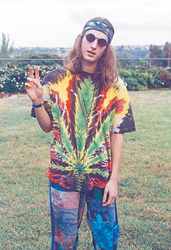
Ever wondered why messy look is so chic these days? This look has comes from the hippie movement that was started by young Americans in 1960s. Young people wanted to distance themselves from the mainstream culture that was rigid and lacked creativity.
Hippies made some drastic changes to their appearances with their fashion choices. Tight and dull tees and monochrome suits were out and loose bright tie-dyes, long skirts with floral and paisley patterns, bell-bottom pants, vest and folk dresses were in. As they were against consumerism, young people wore handmade and recycled clothes and accessories. Beaded necklaces, garlands, headbands, gypsy scarves were used as adornments; long unkempt hair became fashionable. African, Asian and Latin American motifs were incorporated. Hippies would have surely infuriated Trump! By the way, hippies are still living happily in America.
Middle-class values and consumerism was frustrating for them; they showed immense courage in opposing a system that focused too much on accumulating wealth. Their mantra “Don’t let society decide how you should dress” became a threat to the booming fashion industry at that time.
Mods - the dandy look 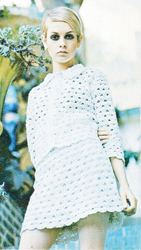
In post-world war era, teens and young adults from affluent families in London began to spend their extra money on stylish tailor-made clothes. Young people got a bit conscious of what they wore; unlike hippies, they wanted to look “refined” and “cultured”. As French and Italian fashion styles were considered the finest, young people copied them. ‘Mods’ wore designer suits with lapels, thin ties, button-down collar shirts, wool jumpers (V-necks) and classy boots; boys spent considerable time on styling their hair for getting that ultimate urbane look. Mod girls kept their hair short, wore makeup and flaunted fake eye-lashes. Miniskirts and men-style clothes got extremely popular among the girls; the models Jean Shrimpton and Twiggy were two teenage models in sixties London who openly represented mod fashion.
Punks - the misfits
Punks are the weirdest! They are bizarre, boorish and dangerous. In movies, the rowdy guy with a Mohawk - a typical punk symbol - is despised and loathed by everyone.
I guess the element of danger is in their clothes and accessories. A typical punk would dye hair in shades of red and blue, put on a spiked leather jacket and ripped trousers and stroll around comfortably in suffocating clunky boots. Body piercing was a must for a typical punk; they pierced holes in parts of the body other than the ear in order to insert rings and studs. Even in Pakistan, you would find young people with their eyebrows and lips pierced. This may sound cruel to others but for punks it was pure adventure.
It all started with music: punks were not happy with what was happening in the music industry. The musicians were producing music for money and fame; loss of creativity and superficiality was upsetting for some young people. So, through their bizarre appearances, they expressed their anger.
Slogan t-shirts were introduced to express the feelings and opinions on global politics. These politically charged slogans made fashion statements during the Cold War era: “No borders, no nations, just people”, “The great royal debate: do we hang them?”, “Pretty disobedient”, “Too fast to live, too young to die”, “All the arms we need”, “Wealth is a ghetto”.
Well, in Pakistan, designers never went beyond catchy phrases like “Be bold”, “Keep calm”, “Nothing to wear”, “This is me” and yes this slogan caught my eyes recently: “Death before disgrace: Pakistan Army”.
A punk’s makeover meant dark lip colours, thick coats of eye-liner and elaborate hairdos; a punk girl dazzled in torn fishnet stockings, spiked armbands and studded jacket.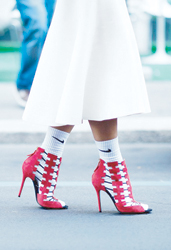
Normcore - a desire to fit in
There are obviously limits to defiance and rebellion; where was that sense of belongingness that bound us together? This movement was a response to the increasing intolerance in the global fashion industry. Youth invested so much of its energy on picking up quirky fashion styles to represent themselves, but with this idea of normcore, they were ready to embrace mainstream fashion, but not at the expense of their individuality. In 2014, Jeanette Hayes, a young internet-inspired artist paired strappy stilettos with athletic socks; other artists played with several other combinations like sport caps were paired with turtlenecks and sweatpants. Slouchy sweaters, hoodies, crop tops, crew necks, loose jeans, white sneakers are just few things that define normcore.
Minimalism: less is more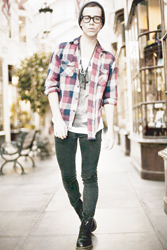
Teenagers and young girls kept things simple in 90s. “Comfort is all we need” became the catchphrase and people seemed weary of the fancy and ornamental dresses. Loose jeans and a plain T-shirt were enough for a high-school student. Girls replaced their bright-coloured clothes with softer shades of green, purple and blue.
During this fashion movement, stonewashed jeans and plaid flannels were introduced. For young women, capris and ‘Rachel’ haircut - Jennifer Aniston wore this haircut in the popular 90s TV show Friends - became fashionable. Young people had real fun experimenting with simple and minimal fashion options.
Modest - the ‘new’ cool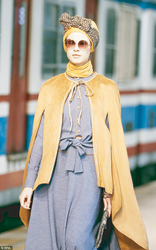
When 19-year-old Halima Aden became the first contestant to wear a hijab and burkini while competing in the Miss Minnesota USA pageant, the concept of a ‘modest’ look was introduced to the fashion world.
During New York Fashion Week in 2016, several models walked on the ramp with dresses featuring gowns, higher cuts, and looser fits. Baggy tunics and chunky knits now look modern.
Then, Anniesa Hasibuan, an Indonesian designer, featured every model on her runway wearing headscarves. The modest fashion designs that were quite boring in the fashion world are now becoming mainstream.
Nothing dominates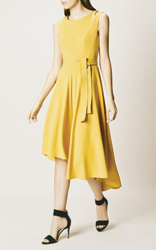
Information is shared at a faster rate than ever before. People are now able to share ideas with millions of people around the world in a matter of seconds. With just few Instagram posts, a designer can give rise to new fashion ideas.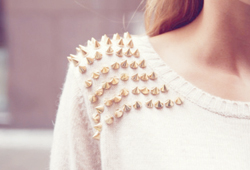 That’s why fashion trends keep changing! The interesting thing is that young people are now more open to diversity which means fusion of trends from several different styles. Our clothes these days have elements from almost all the fashion movements. Vintage looks, tribal and floral patterns are taken from hippie movement; leather and denim jackets, studded bags and accessories come from punks; normcore athletic attire is now an everyday wear; miniskirts and button-down blazer jackets with thin ties from Mod fashion movement are still classy today.
That’s why fashion trends keep changing! The interesting thing is that young people are now more open to diversity which means fusion of trends from several different styles. Our clothes these days have elements from almost all the fashion movements. Vintage looks, tribal and floral patterns are taken from hippie movement; leather and denim jackets, studded bags and accessories come from punks; normcore athletic attire is now an everyday wear; miniskirts and button-down blazer jackets with thin ties from Mod fashion movement are still classy today.
In Pakistan, kurtis with asymmetrical cuts are very close to hippie dresses which came in every size and shape. There are no rules; cut and shape your shirt in any way you like.
|
While talking about her fashion designing education, she said, “At fashion schools, we are given ample freedom to experiment and try crazy things! In my sixth semester, I created a floral pattern with colourful safety pins on a crop top. Some were using pebbles, sand and tiny pieces of mirror on denim fabric for making designs. During my time in university, I found teachers who really encouraged students to go ahead with their out-of-this-world ideas. You would find people doing all sorts of interesting things in fashion schools, but as soon as they enter the industry, they have to do things according to the specific standards in the industry. If tribal prints are in, you have to come up with tribal patterns for your company; if embroidered shirts are in demand, you have to create designs for them. Basically, you are doing what’s mainstream; the other way is to open up your own fashion houses which is not easy for many young designers. Lack of money and supervision are two major problems.” |
|
At the channel, we have to keep an eye on the fashion trends. We can’t afford to show out-dated fashion styles and trends on screen; the fear of losing ratings is frustrating. For instance, right now, short shirts are in fashion so we can’t let women wear long shirts on our sets. But, I am completely against this attitude. Fashion should be a way to express yourself! We can have preferences, but we can’t impose them on others.” |